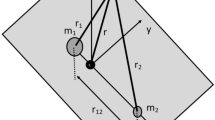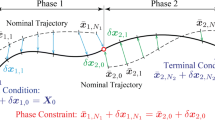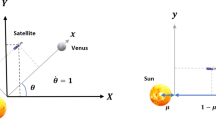Abstract
After the Chang’e-2 spacecraft conducted a successful asteroid flyby, where is it flying to in interplanetary space? This question is answered via an introduction to the Chang’e-2’s flight trajectory after asteroid flyby that is termed Earth co-orbital motion. Based on preliminary analysis using the dynamical systems theory, Poincaré sections concept, and routine optimization techniques, it is now predicted that, from the point of view of orbital mechanics, Chang’e-2 is capable of returning to the vicinity of the Earth in no more than 20 a and might be recaptured by the Earth if appropriate orbital maneuvers are going to be exerted, either by itself or by another spacecraft that captures Chang’e-2.





Similar content being viewed by others
References
Gao Y, Li H, He S (2012) First-round design of flight scenario for Chang’e-2’s extended mission: taking off from lunar orbit. Acta Mech Sin 28:1466–1478
Wu WR, Cui PY, Qiao D et al. (2012) Design and performance of exploring trajectory to Sun-Earth L2 point for Chang’e-2 mission. Chin Sci Bull (Chin Ver) 57:1987–1991 (in Chinese)
Xu M, Tan T, Xu S (2012) Research of the transfers to Halo orbits from the view of invariant manifolds. Sci China Phys Mech Astron 55:671–683
Gao Y (2013) Near-Earth asteroid flyby trajectories from the Sun-Earth L2 for Chang’e-2’s extended flight. Acta Mech Sin 29:123–131
Szebehely V (1967) Theory of orbits: the restricted problem of three bodies. Academic Press, New York
Howell KC (2001) Families of orbits in the vicinity of the collinear libration points. J Astronaut Sci 49:125–197
Richardson DL (1980) Analytic construction of periodic orbits about the collinear point. Celest Mech 22:241–253
Connors M, Chodas P, Mikkola S et al (2002) Discovery of an asteroid and quasi-satellite in an Earth-like horseshoe orbit. Meteorit Planet Sci 37:1435–1441
Barrabes E, Mikkola S (2005) Families of periodic horseshoe orbits in the restricted three-body problem. Astron Astrophys 432:1115–1129
Christou AA, Asher DJ (2011) A long-lived horseshoe companion to the Earth. Monthly Not Royal Astron Soc 414:2965–2969
Wajer P (2010) Dynamical evolution of Earth’s quasi-satellites: 2004 GU9 and 2006 FV35. Icarus 209:488–493
Connors M, Wiegert P, Veillet C (2011) Earth’s Trojan asteroid. Nature 475:481–483
Gomez G, Koon WS, Lo MW et al (2001) Invariant manifolds, the spatial three-body problem and space mission design, AAS-01-301, AAS/AIAA astrodynamics specialist conference, Quebec City
Acknowledgments
The author would like to thank Prof. Hengnian Li, the deputy director of the State Key Laboratory of Astronautic Dynamics, for providing the Chang’e-2’s orbital states on Feb 21, 2013, which is a primary motivation to conduct this study; Prof. Jiangchuan Huang, the Chief Designer of the Chang’e-2 spacecraft; the other anonymous reviewers for their valuable revision suggestions.
Author information
Authors and Affiliations
Corresponding author
About this article
Cite this article
Gao, Y. The analysis of the Earth co-orbital motion of Chang’e-2 after asteroid flyby. Chin. Sci. Bull. 59, 2045–2049 (2014). https://doi.org/10.1007/s11434-014-0274-x
Received:
Accepted:
Published:
Issue Date:
DOI: https://doi.org/10.1007/s11434-014-0274-x




